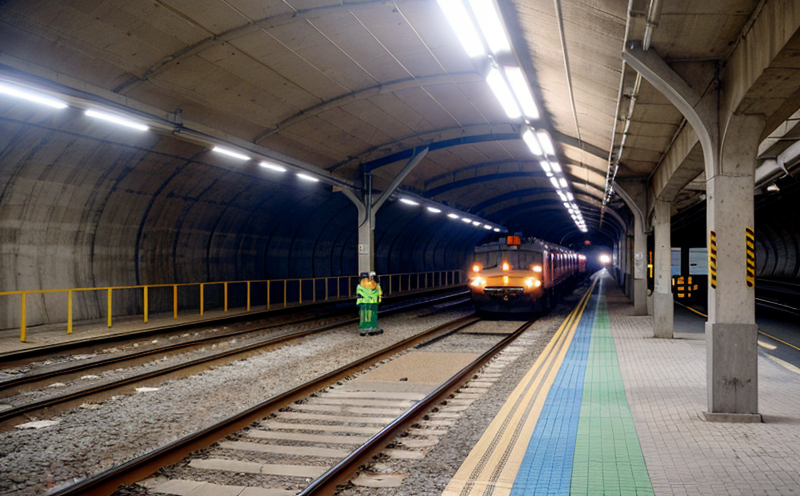ISO 2631-2 Vibration Testing of Passenger Areas in Stations
The ISO 2631-2 standard is a crucial benchmark in ensuring the safety and comfort of passengers within railway stations. This standard provides guidelines for the measurement, evaluation, and control of vibration exposure to seated or standing individuals, especially in passenger areas such as waiting rooms, platforms, and concourses.
The primary objective of ISO 2631-2 is to protect human health by establishing a framework to assess the effects of vibration on passengers. This standard is particularly relevant for railway stations where high-frequency vibrations can be prevalent due to various factors including train movements, foot traffic, and HVAC systems. The testing procedure ensures that the levels of vibration experienced do not exceed safe limits as defined in international standards.
The testing process involves several key steps: identification of critical areas within the station, measurement of vibration using accelerometers placed at strategic points, analysis of data to determine compliance with the standard, and finally, reporting findings. Compliance is assessed based on the Root Mean Square (RMS) values derived from the measurements.
The testing apparatus typically includes a variety of sensors such as piezoelectric accelerometers that are calibrated according to ISO 9609:2014 and fixed at different heights within the station. These sensors capture vibration data in real-time, which is then analyzed using sophisticated software tools adhering to the guidelines provided by ISO standards.
Compliance with ISO 2631-2 is essential for several reasons. Firstly, it ensures that passengers experience a comfortable environment free from excessive vibrations that could lead to discomfort or health issues. Secondly, compliance helps railway operators meet regulatory requirements and build trust among their customers. Lastly, it supports continuous improvement in station design and operation.
Real-world applications of this testing include the integration into new station designs during the planning phase as well as periodic evaluations for existing structures. By adhering to ISO 2631-2, railway operators can enhance passenger satisfaction and maintain a safe environment, which is critical given the high volume of daily foot traffic in stations.
For quality managers and compliance officers, understanding these standards is vital. Proper implementation ensures that all stakeholders—from architects designing new stations to maintenance teams monitoring existing ones—are working towards the same goal: providing a safe and comfortable travel experience.
Applied Standards
The ISO 2631-2 standard is closely aligned with other international standards such as ISO 9609 for accelerometer calibration, which ensures that all measurement devices used in the testing process are accurate. Additionally, ISO 8528 provides specifications for shaker tables and vibration test machines, ensuring the reliability of the equipment employed.
The standard also draws from EN 1343-1:2006, which deals with the design of railway wagons, to ensure that the testing methodology is comprehensive. This integration allows for a holistic approach to vibration control, addressing not just passenger areas but also other parts of the station infrastructure.
In summary, these standards collectively form a robust framework that supports accurate and consistent vibration testing in railway stations, ensuring both safety and comfort for passengers.
Industry Applications
- New Station Construction: During the planning stages of new railway station projects, ISO 2631-2 is used to assess potential vibration levels. This helps architects design structures that minimize discomfort for passengers.
- Retrofitting Existing Stations: For stations undergoing renovations or expansions, this standard ensures that any modifications do not introduce excessive vibrations into the environment.
- Maintenance and Upkeep: Regular testing of existing stations allows operators to identify and address issues before they become serious problems affecting passenger satisfaction and safety.
- Research & Development: Engineers use this standard as a benchmark when developing new materials or technologies aimed at reducing vibration in railway environments.
The application of ISO 2631-2 is not limited to the above scenarios. It also plays a role in optimizing HVAC systems, ensuring that equipment operation does not contribute significantly to unwanted vibrations within passenger areas.
Why Choose This Test
- Promotes Safety: By adhering to ISO 2631-2, railway operators can ensure that the vibration levels experienced by passengers are well within safe limits, thus preventing potential health risks.
- Enhances Passenger Comfort: The standard focuses on creating environments where passengers feel comfortable and at ease. This is particularly important given the significant time many people spend in stations daily.
- Achieves Regulatory Compliance: Many countries have regulations that mandate compliance with international standards like ISO 2631-2, making it essential for railway operators to conduct these tests regularly.
- Improves Reputation and Trust: Demonstrating adherence to such high standards helps build a positive reputation among passengers and stakeholders, enhancing overall trust in the organization.
- Sustains Continuous Improvement: Regular testing provides valuable insights into ongoing performance, enabling continuous improvement in station design and operations.
- Reduces Maintenance Costs: Identifying and addressing issues early through vibration testing can prevent more extensive repairs later on, thereby reducing long-term maintenance costs.
Choosing ISO 2631-2 Vibration Testing ensures that railway stations meet the highest standards of safety and comfort. This approach not only enhances passenger satisfaction but also contributes to the overall efficiency and sustainability of railway operations.





